Disney Princesses After Beung Molested by Their Uncles
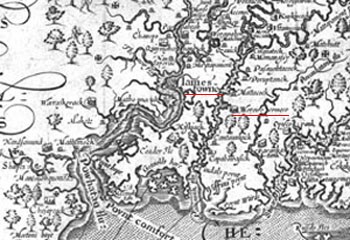
John Smith's Map of 1612
Not much is known about this memorable woman. What we do know was written by others, as none of her thoughts or feelings were ever recorded. Specifically, her story has been told through written historical accounts and, most recently, through the sacred oral history of the Mattaponi. Most notably, Pocahontas has left an indelible impression that has endured for more than 400 years. And yet, many people who know her name do not know much about her.
The Written History
Pocahontas was born about 1596 and named "Amonute," though she also had a more private name of Matoaka. She was called "Pocahontas" as a nickname, which meant "playful one," because of her frolicsome and curious nature. She was the daughter of Wahunsenaca (Chief Powhatan), the mamanatowick (paramount chief) of the Powhatan Chiefdom. At its height, the Powhatan Chiefdom had a population of about 25,000 and included more than 30 Algonquian speaking tribes - each with its own werowance (chief). The Powhatan Indians called their homeland "Tsenacomoco."
As the daughter of the paramount chief Powhatan, custom dictated that Pocahontas would have accompanied her mother, who would have gone to live in another village, after her birth (Powhatan still cared for them). However, nothing is written by the English about Pocahontas' mother. Some historians have theorized that she died during childbirth, so it is possible that Pocahontas did not leave like most of her half-siblings. Either way, Pocahontas would have eventually returned to live with her father Powhatan and her half-siblings once she was weaned. Her mother, if still living, would then have been free to remarry.
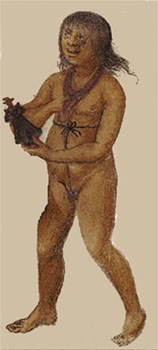
Unknown British Museum
As a young girl, Pocahontas would have worn little to no clothing and had her hair shaven except for a small section in the back that was grown out long and usually braided. The shaven parts were probably bristly most of the time as the Powhatan Indians used mussel shells for shaving. In winter, she could have worn a deerskin mantle (not everyone could afford one). As she grew, she would have been taught women's work; even though the favorite daughter of the paramount chief Powhatan afforded her a more privileged lifestyle and more protection, she still needed to know how to be an adult woman.
Women's work was separate from men's work, but both were equally taxing and equally important as both benefited all Powhatan society. As Pocahontas would learn, besides bearing and rearing children, women were responsible for building the houses (called yehakins by the Powhatan), which they may have owned. Women did all the farming, (planting and harvesting), the cooking (preparing and serving), collected water needed to cook and drink, gathered firewood for the fires (which women kept going all the time), made mats for houses (inside and out), made baskets, pots, cordage, wooden spoons, platters and mortars. Women were also barbers for the men and would process any meat the men brought home as well as tanning hides to make clothing.
Another important thing Pocahontas had to learn to be an adult woman was how to collect edible plants. As a result, she would need to identify the various kinds of useful plants and have the ability to recognize them in all seasons. All of the skills it took to be an adult woman Pocahontas would have learned by the time she was about thirteen, which was the average age Powhatan women reached puberty.
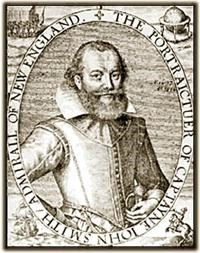
Unknown Artist
When the English arrived and settled Jamestown in May 1607, Pocahontas was about eleven years old. Pocahontas and her father would not meet any Englishmen until the winter of 1607, when Captain John Smith (who is perhaps as famous as Pocahontas) was captured by Powhatan's brother Opechancanough. Once captured, Smith was displayed at several Powhatan Indian towns before being brought to the capital of the Powhatan Chiefdom, Werowocomoco, to Chief Powhatan.
What happened next is what has kept the names of Pocahontas and Captain John Smith inextricably linked: the famous rescue of John Smith by Pocahontas. As Smith tells it, he was brought in front of Chief Powhatan, two large stones were placed on the ground, Smith's head was forced upon them, and a warrior raised a club to smash in his brains. Before this could happen, Pocahontas rushed in and placed her head upon his, which stopped the execution. Whether this event actually happened or not has been debated for centuries. One theory posits that what took place was an elaborate adoption ceremony; its adherents believe that Smith's life was never in danger (though, he most likely would not have known that). Afterwards, Powhatan told Smith he was part of the tribe. In return for "two great guns and a grindstone," Powhatan would give Smith Capahowasick (on the York River), and "forever esteem him as his son Nantaquoud." Smith was then allowed to leave Werowocomoco.
Once Smith returned to Jamestown, Chief Powhatan sent gifts of food to the starving English. These envoys were usually accompanied by Pocahontas, as she was a sign of peace to the English. On her visits to the fort, Pocahontas was seen cart-wheeling with the young English boys, living up to her nickname of "playful one."
The English knew Pocahontas was the favorite daughter of the great Powhatan, and was consequently seen as a very important person. On one occasion, she was sent to negotiate for the release of Powhatan prisoners. According to John Smith, it was for and to Pocahontas alone that he finally released them. As time passed, however, relations between the Powhatan Indians and the English began to deteriorate, but Pocahontas's relationship with the newcomers was not over.
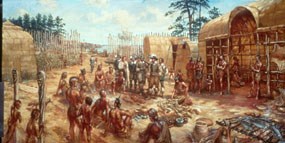
NPS Image
By the winter of 1608-1609, the English visited various Powhatan tribes to trade beads and other trinkets for more corn, only to find a severe drought had drastically reduced the tribes' harvests. In addition, Powhatan's official policy for his chiefdom was to cease trading with the English. The settlers were demanding more food than his people had to spare, so the English were threatening the tribes and burning towns to get it. Chief Powhatan sent a message to John Smith, telling him if he brought to Werowocomoco swords, guns, hens, copper, beads, and a grindstone, he would have Smith's ship loaded with corn. Smith and his men visited Powhatan to make the exchange, and ended up stranding their barge. Negotiations did not go well. Powhatan excused himself, then he and his family, including Pocahontas, departed into the woods, unbeknownst to Smith and his men. According to Smith, that night Pocahontas returned to warn him that her father intended to kill him. Smith had already suspected something was wrong, but was still grateful that Pocahontas was willing to risk her life to save his yet again. Afterwards, she disappeared into the woods, never to see Smith in Virginia again.
As relations between the two peoples deteriorated, Chief Powhatan, wearied of the constant English demand for food, moved his capital from Werowocomoco (on the York River) in 1609 to Orapaks (on the Chickahominy River), further inland. Pocahontas was not allowed to visit Jamestown anymore. In the fall of 1609 Smith left Virginia because of a severe gunpowder wound. Pocahontas and Powhatan were told that Smith died on the way back to England.
Pocahontas stopped visiting the English, but that was not the end of her involvement with them. John Smith recorded that she saved the life of Henry Spelman, one of several English boys who had been sent to live with the Powhatan Indians to learn their language and lifeways (Powhatan Indian boys had been sent to live with the English to learn about English ways and language as well). By 1610, Spelman did not feel as welcome among the Powhatan Indians and ran away with two other boys, Thomas Savage and Samuel (a Dutchman; last name unknown). Savage changed his mind, returned to Powhatan, and told him about the runaways. According to Spelman, Powhatan was angry about losing his translators and sent men to retrieve the boys. Samuel was killed during the pursuit, but Spelman escaped to live among the Patawomeck tribe (an outlying member of the Powhatan Chiefdom). His account says he made his way alone to the Patawomeck, but Smith, who spoke with Pocahontas years later, said she had helped Spelman get to safety.
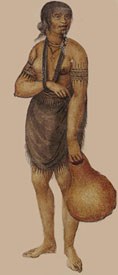
Unknown British Museum
The years 1609-1610 would be important ones for Pocahontas. Pocahontas, who was about fourteen, had reached adulthood and marriageable age. She began to dress like a Powhatan woman, wearing a deerskin apron and a leather mantle in winter, since she was of high status. She might also wear one-shouldered fringed deerskin dresses when encountering visitors. Pocahontas started decorating her skin with tattoos. When she traveled in the woods, she would have worn leggings and a breechclout to protect against scratches, as they could become easily infected. She would have also grown her hair out and worn it in a variety of ways: loose, braided into one plait with bangs, or, once married, cut short the same length all around.
In 1610, Pocahontas married Kocoum, whom Englishman William Strachey described as a "private captain." Kocoum was not a chief or a councilor, though mention of his being a "private captain" implies he had command over some men. The fact that he was not a chief, and thus not high in status, suggests that Pocahontas may have married for love. Kocoum may have been a member of the Patawomeck tribe. He also might have been a member of her father Powhatan's bodyguards. Pocahontas remained close to her father and continued to be his favorite daughter after her marriage, as the English accounts imply. Although Pocahontas was the favorite daughter of the paramount chief, she still had the freedom to choose whom she married, as did other women in Powhatan society.
For the next several years, Pocahontas was not mentioned in the English accounts. In 1613, that changed when Captain Samuel Argall discovered she was living with the Patawomeck. Argall knew relations between the English and the Powhatan Indians were still poor. Capturing Pocahontas could give him the leverage he needed to change that. Argall met with Iopassus, chief of the town of Passapatanzy and brother to the Patawomeck tribe's chief, to help him kidnap Pocahontas. At first, the chief declined, knowing Powhatan would punish the Patawomeck people. Ultimately, the Patawomeck decided to cooperate with Argall; they could tell Powhatan they acted under coercion. The trap was set.
Pocahontas accompanied Iopassus and his wife to see Captain Argall's English ship. Iopassus' wife then pretended to want to go aboard, a request her husband would grant only if Pocahontas would accompany her. Pocahontas refused at first, sensing something was not right, but finally agreed when Iopassus' wife resorted to tears. After eating, Pocahontas was taken to the gunner's room to spend the night. In the morning, when the three visitors were ready to disembark, Argall refused to allow Pocahontas to leave the ship. Iopassus and his wife seemed surprised; Argall declared Pocahontas was being held as ransom for the return of stolen weapons and English prisoners held by her father. Iopassus and his wife left, with a small copper kettle and some other trinkets as a reward for their part in making Pocahontas an English prisoner.
After her capture, Pocahontas was brought to Jamestown. Eventually, she was probably taken to Henrico, a small English settlement near present-day Richmond. Powhatan, informed of his daughter's capture and ransom cost, agreed to many of the English demands immediately, to open negotiations. In the meantime, Pocahontas was put under the charge of Reverend Alexander Whitaker, who lived at Henrico. She learned the English language, religion and customs. While not all was strange to Pocahontas, it was vastly different than the Powhatan world.
During her religious instruction, Pocahontas met widower John Rolfe, who would become famous for introducing the cash crop tobacco to the settlers in Virginia. By all English accounts, the two fell in love and wanted to marry. (Perhaps, once Pocahontas was kidnapped, Kocoum, her first husband, realized divorce was inevitable (there was a form of divorce in Powhatan society). Once Powhatan was sent word that Pocahontas and Rolfe wanted to marry, his people would have considered Pocahontas and Kocoum divorced.) Powhatan consented to the proposed marriage and sent an uncle of Pocahontas' to represent him and her people at the wedding.
In 1614, Pocahontas converted to Christianity and was baptized "Rebecca." In April 1614, she and John Rolfe married. The marriage led to the "Peace of Pocahontas;" a lull in the inevitable conflicts between the English and Powhatan Indians. The Rolfes soon had a son named Thomas. The Virginia Company of London, who had funded the settling of Jamestown, decided to make use of the favorite daughter of the great Powhatan to their advantage. They thought, as a Christian convert married to an Englishman, Pocahontas could encourage interest in Virginia and the company.
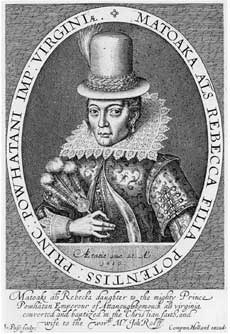
Unknown British Museum
The Rolfe family traveled to England in 1616, their expenses paid by the Virginia Company of London. Pocahontas, known as "Lady Rebecca Rolfe," was also accompanied by about a dozen Powhatan men and women. Once in England, the party toured the country. Pocahontas attended a masque where she sat near King James I and Queen Anne. Eventually, the Rolfe family moved to rural Brentford, where Pocahontas would again encounter Captain John Smith.
Smith had not forgotten about Pocahontas and had even written a letter to Queen Anne describing all she had done to help the English in Jamestown's early years. Pocahontas had been in England for months, though, before Smith visited her. He wrote that she was so overcome with emotion that she could not speak and turned away from him. Upon gaining her composure, Pocahontas reprimanded Smith for the manner in which he had treated her father and her people. She reminded him how Powhatan had welcomed him as a son, how Smith had called him "father." Pocahontas, a stranger in England, felt she should call Smith "father." When Smith refused to allow her to do so, she became angrier and reminded him how he had not been afraid to threaten every one of her people - except her. She said the settlers had reported Smith had died after his accident, but that Powhatan had suspected otherwise as "your countrymen will lie much."
In March 1617, the Rolfe family was ready to return to Virginia. After traveling down the Thames River, Pocahontas, seriously ill, had to be taken ashore. In the town of Gravesend, Pocahontas died of an unspecified illness. Many historians believe she suffered from an upper respiratory ailment, such as pneumonia, while others think she could have died from some form of dysentery. Pocahontas, about twenty-one, was buried at St. George's Church on March 21, 1617. John Rolfe returned to Virginia, but left the young ailing Thomas with relatives in England. Within a year, Powhatan died. The "Peace of Pocahontas" began to slowly unravel. Life for her people would never be the same.
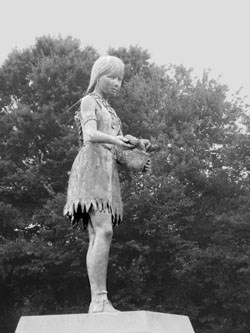
Angela L. Daniel "Silver Star"
The recently published (2007)
The True Story of Pocahontas: The Other Side of Historyby Dr. Linwood "Little Bear" Custalow and Angela L. Daniel "Silver Star," based on the sacred oral history of the Mattaponi tribe, offers some further, and sometimes very different, insights into the real Pocahontas.
Pocahontas was the last child of Wahunsenaca (Chief Powhatan) and his first wife Pocahontas, his wife of choice and of love. Pocahontas' mother died during childbirth. Their daughter was given the name Matoaka which meant "flower between two streams." The name probably came from the fact that the Mattaponi village was located between the Mattaponi and Pamunkey Rivers and that her mother was Mattaponi and her father Pamunkey.
Wahunsenaca was devastated by the loss of his wife, but found joy in his daughter. He often called her Pocahontas, which meant "laughing and joyous one," since she reminded him of his beloved wife. There was no question that she was his favorite and that the two had a special bond. Even so, Wahunsenaca thought it best to send her to be raised in the Mattaponi village rather than at his capital of Werowocomoco. She was raised by her aunts and cousins, who took care of her as if she were their own.
Once Pocahontas was weaned, she returned to live with her father at Werowocomoco. Wahunsenaca had other children with Pocahontas' mother as well as with his alliance wives, but Pocahontas held a special place in her father's heart. Pocahontas held a special love and respect for her father as well. All of the actions of Pocahontas or her father were motivated by their deep love for each other, their deep and strong bond. The love and bond between them never wavered. Most of her older siblings were grown, as Wahunsenaca fathered Pocahontas later in his life. Many of her brothers and sisters held prominent positions within Powhatan society. Her family was very protective of her and saw to it that she was well looked after.
As a child, Pocahontas' life was very different than as an adult. The distinction between childhood and adulthood was visible through physical appearance as well as through behavior. Pocahontas would not have cut her hair or worn clothing until she came of age (in winter she wore a covering to protect against the cold). There were also certain ceremonies she was not allowed to participate in or even witness. Even as a child, the cultural standards of Powhatan society applied to her, and in fact, as the daughter of the paramount chief, more responsibility and discipline were expected of her. Pocahontas also received more supervision and training; as Wahunsenaca's favorite daughter she probably had even more security, as well.
When the English arrived, the Powhatan people welcomed them. They desired to become friends and trade with the settlers. Each tribe within the Powhatan Chiefdom had quiakros (priests), who were spiritual leaders, political advisors, medical doctors, historians and enforcers of Powhatan behavioral norms. The quiakros advised containing the English and making them allies to the Powhatan people. Wahunsenaca agreed with the quiakros. During the winter of 1607 the friendship was solidified.
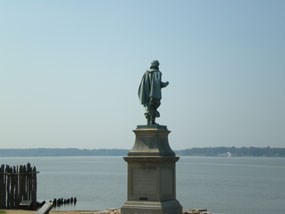
Sarah J Stebbins
The most famous event of Pocahontas' life, her rescue of Captain John Smith, did not happen the way he wrote it. Smith was exploring when he encountered a Powhatan hunting party. A fight ensued, and Smith was captured by Opechancanough. Opechancanough, a younger brother of Wahunsenaca, took Smith from village to village to demonstrate to the Powhatan people that Smith, in particular, and the English, in general, were as human as they were. The "rescue" was a ceremony, initiating Smith as another chief. It was a way to welcome Smith, and, by extension, all the English, into the Powhatan nation. It was an important ceremony, so the quiakros would have played an integral role.
Wahunsenaca truly liked Smith. He even offered a healthier location for the English, Capahowasick (east of Werowocomoco). Smith's life was never in danger. As for Pocahontas, she would not have been present, as children were not allowed at religious rituals. Afterwards, Pocahontas would have considered Smith a leader and defender of the Powhatan people, as an allied chief of the English tribe. She would have expected Smith to be loyal to her people, since he had pledged friendship to Wahunsenaca. In Powhatan society, one's word was one's bond. That bond was sacred.
The English had been welcomed by the Powhatan people. To cement this new alliance, Wahunsenaca sent food to Jamestown during the winter of 1607-08. Doing so was the Powhatan way, as leaders acted for the good of the whole tribe. It was during these visits to the fort with food that Pocahontas became known to the English, as a symbol of peace. Since she was still a child, she would not have been allowed to travel alone or without adequate protection and permission from her father. The tight security that surrounded Pocahontas at Jamestown, though often disguised, may have been how the English realized she was Wahunsenaca's favorite.
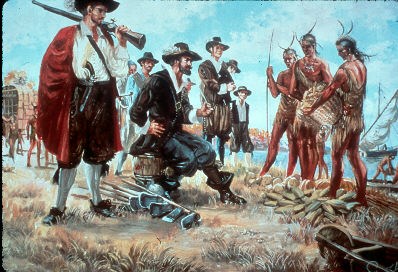
NPS Image
Over time, relations between the Powhatan Indians and the English began to deteriorate. The settlers were aggressively demanding food that, due to summer droughts, could not be provided. In January 1609, Captain John Smith paid an uninvited visit to Werowocomoco. Wahunsenaca reprimanded Smith for English conduct, in general, and for Smith's own, in particular. He also expressed his desire for peace with the English. Wahunsenaca followed the Powhatan philosophy of gaining more through peaceful and respectful means than through war and force. According to Smith, during this visit Pocahontas again saved his life by running through the woods that night to warn him her father intended to kill him. However, as in 1607, Smith's life was not in danger. Pocahontas was still a child, and a very well protected and supervised one; it is unlikely she would have been able to provide such a warning. It would have gone against Powhatan cultural standards for children. If Wahunsenaca truly intended to kill Smith, Pocahontas could not have gotten past Smith's guards, let alone prevented his death.
As relations continued to worsen between the two peoples, Pocahontas stopped visiting, but the English did not forget her. Pocahontas had her coming of age ceremony, which symbolized that she was eligible for courtship and marriage. This ceremony took place annually and boys and girls aged twelve to fourteen took part. Pocahontas' coming of age ceremony (called a huskanasquaw for girls) took place once she began to show signs of womanhood. Since her mother was dead, her older sister Mattachanna oversaw the huskanasquaw, during which Wahunsenaca's daughter officially changed her name to Pocahontas. The ceremony itself was performed discreetly and more secretly than usual because the quiakros had heard rumors the English planned to kidnap Pocahontas.
After the ceremony a powwow was held in celebration and thanksgiving. During the powwow, a courtship dance allowed single male warriors to search for a mate. It was most likely during this dance that Pocahontas met Kocoum. After a courtship period, the two married. Wahunsenaca was happy with Pocahontas' choice, as Kocoum was not only the brother of a close friend of his, Chief Japazaw (also called Iopassus) of the Potowomac (Patawomeck) tribe, but was also one of his finest warriors. He knew Pocahontas would be well protected.
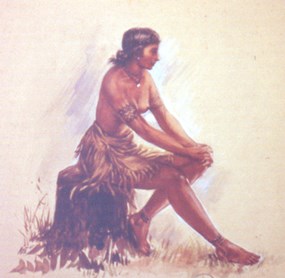
NPS Image
Rumors of the English wanting to kidnap Pocahontas resurfaced, so she and Kocoum moved to his home village. While there, Pocahontas gave birth to a son. Then, in 1613, the long suspected English plan to kidnap Pocahontas was carried out. Captain Samuel Argall demanded the help of Chief Japazaw. A council was held with the quiakros, while word was sent to Wahunsenaca. Japazaw did not want to give Pocahontas to Argall; she was his sister-in-law. However, not agreeing would have meant certain attack by a relentless Argall, an attack for which Japazaw's people could offer no real defense. Japazaw finally chose the lesser of two evils and agreed to Argall's plan, for the good of the tribe. To gain the Captain's sympathy and possible aid, Japazaw said he feared retaliation from Wahunsenaca. Argall promised his protection and assured the chief that no harm would come to Pocahontas. Before agreeing, Japazaw made a further bargain with Argall: the captain was to release Pocahontas soon after she was brought aboard ship. Argall agreed. Japazaw's wife was sent to get Pocahontas. Once Pocahontas was aboard, Argall broke his word and would not release her. Argall handed a copper kettle to Japazaw and his wife for their "help" and as a way to implicate them in the betrayal.
Before Captain Argall sailed off with his captive, he had her husband Kocoum killed - luckily their son was with another woman from the tribe. Argall then transported Pocahontas to Jamestown; her father immediately returned the English prisoners and weapons to Jamestown to pay her ransom. Pocahontas was not released and instead was put under the care of Sir Thomas Gates, who supervised the ransom and negotiations. It had been four years since Pocahontas had seen the English; she was now about fifteen or sixteen years old.
A devastating blow had been dealt to Wahunsenaca and he fell into a deep depression. The quiakros advised retaliation. But, Wahunsenaca refused. Ingrained cultural guidelines stressed peaceful solutions; besides he did not wish to risk Pocahontas being harmed. He felt compelled to choose the path that best ensured his daughter's safety.
While in captivity, Pocahontas too became deeply depressed, but submitted to the will of her captors. Being taken into captivity was not foreign, as it took place between tribes, as well. Pocahontas would have known how to handle such a situation, to be cooperative. So she was cooperative, for the good of her people, and as a means of survival. She was taught English ways, especially the settlers' religious beliefs, by Reverend Alexander Whitaker at Henrico. Her captors insisted her father did not love her and told her so continuously. Overwhelmed, Pocahontas suffered a nervous breakdown, and the English asked that a sister of hers be sent to care for her. Her sister Mattachanna, who was accompanied by her husband, was sent. Pocahontas confided to Mattachanna that she had been raped and that she thought she was pregnant. Hiding her pregnancy was the main reason Pocahontas was moved to Henrico after only about three months at Jamestown. Pocahontas eventually gave birth to a son named Thomas. His birthdate is not recorded, but the oral history states that she gave birth before she married John Rolfe.
In the spring of 1614, the English continued to prove to Pocahontas that her father did not love her. They staged an exchange of Pocahontas for her ransom payment (actually the second such payment). During the exchange, a fight broke out and negotiations were terminated by both sides. Pocahontas was told this "refusal" to pay her ransom proved her father loved English weapons more than he loved her.
Shortly after the staged ransom exchange, Pocahontas converted to Christianity and was renamed Rebecca. In April 1614, Pocahontas and John Rolfe were married at Jamestown. Whether she truly converted is open to question, but she had little choice. She was a captive who wanted to represent her people in the best light and to protect them. She probably married John Rolfe willingly, since she already had a half-white child who could help create a bond between the two peoples. Her father consented to the marriage, but only because she was being held captive and he feared what might happen if he said no. John Rolfe married Pocahontas to gain the help of the quiakros with his tobacco crops, as they were in charge of tobacco. With the marriage, important kinship ties formed and the quiakros agreed to help Rolfe.
In 1616, the Rolfes and several Powhatan representatives, including Mattachanna and her husband Uttamattamakin, were sent to England. Several of these representatives were actually quiakros in disguise. By March 1617, the family was ready to return to Virginia after a successful tour arranged to gain English interest in Jamestown. While on the ship Pocahontas and her husband dined with Captain Argall. Shortly after, Pocahontas became very ill and began convulsing. Mattachanna ran to get Rolfe for help. When they returned, Pocahontas was dead. She was taken to Gravesend and buried in its church. Young Thomas was left behind to be raised by relatives in England, while the rest of the party sailed back to Virginia.
Wahunsenaca was told by Mattachanna, Uttamattamakin and the disguised quiakros that his daughter had been murdered. Poison was suspected as she had been in good health up until her dinner on the ship. Wahunsenaca sank into despair at the loss of his beloved daughter, the daughter he had sworn to his wife he would protect. Eventually, he was relieved as paramount chief and, by April 1618, he was dead. The peace began to unravel and life in Tsenacomoco would never be the same for the Powhatan people.
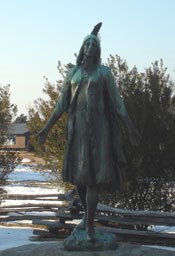
Sarah J Stebbins
Conclusion
What little we know about Pocahontas covers only about half of her short life and yet has inspired a myriad of books, poems, paintings, plays, sculptures, and films. It has captured the imagination of people of all ages and backgrounds, scholars and non-scholars alike. The truth of Pocahontas' life is shrouded in interpretation of both the oral and written accounts, which can contradict one another. One thing can be stated with certainty: her story has fascinated people for more than four centuries and it still inspires people today. It will undoubtedly continue to do so. She also still lives on through her own people, who are still here today, and through the descendents of her two sons.
Author's note: There are various spellings for the names of people, places and tribes. In this paper I have endeavored to use one spelling throughout, unless otherwise noted.
Bibliography
Custalow, Dr. Linwood "Little Bear" and Angela L. Daniel "Silver Star." The True Story of Pocahontas: The Other Side of History. Golden: Fulcrum Publishing, 2007.
Haile, Edward Wright (editor) Jamestown Narratives: Eyewitness Accounts of the Virginia Colony: The First Decade: 1607-1617. Chaplain: Roundhouse, 1998.
Mossiker, Frances. Pocahontas: The Life and The Legend. New York: Da Capo Press, 1976.
Rountree, Helen C. and E. Randolph Turner III. Before and After Jamestown: Virginia's Powhatans and Their Predecessors. Gainesville: University Press of Florida, 1989.
Rountree, Helen C. Pocahontas, Powhatan, Opechancanough: Three Indian Lives Changed by Jamestown. Charlottesville: University of Virginia Press, 2005.
Rountree, Helen C. The Powhatan Indians of Virginia: Their Traditional Culture. Norman: University of Oklahoma Press, 1989.
Towsned, Camilla. Pocahontas and the Powhatan Dilemma: The American Portrait Series. New York: Hill And Wang, 2004.
Sarah J Stebbins NPS Seasonal, August 2010
Available online through the National Park Service is A Study of Virginia Indians and Jamestown: THE FIRST CENTURY by Danielle Moretti-Langholtz, Ph.D.
Disney Princesses After Beung Molested by Their Uncles
Source: https://www.nps.gov/jame/learn/historyculture/pocahontas-her-life-and-legend.htm
0 Response to "Disney Princesses After Beung Molested by Their Uncles"
Post a Comment